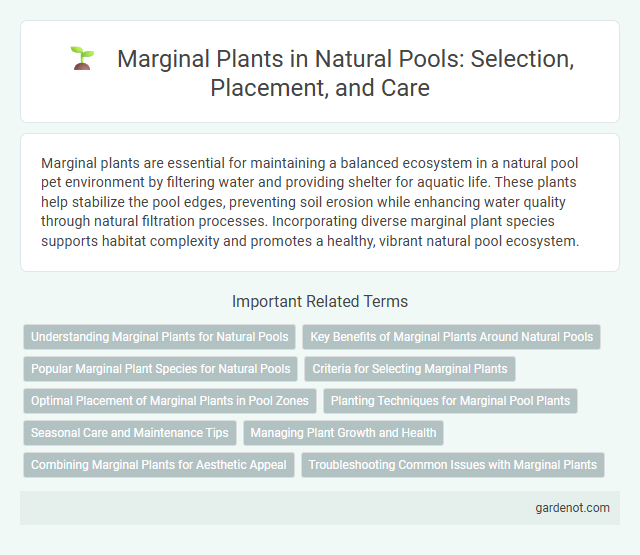Marginal plants are essential for maintaining a balanced ecosystem in a natural pool pet environment by filtering water and providing shelter for aquatic life. These plants help stabilize the pool edges, preventing soil erosion while enhancing water quality through natural filtration processes. Incorporating diverse marginal plant species supports habitat complexity and promotes a healthy, vibrant natural pool ecosystem.
Understanding Marginal Plants for Natural Pools
Marginal plants play a crucial role in natural pools by enhancing water quality and providing habitat for aquatic life through root filtration and oxygenation. Common species such as cattails (Typha spp.), irises (Iris spp.), and pickerelweed (Pontederia cordata) thrive in shallow waters, helping to stabilize the pool's edge and prevent erosion. Incorporating diverse marginal plants supports ecological balance, reduces algae growth, and promotes a sustainable, self-cleaning aquatic environment.
Key Benefits of Marginal Plants Around Natural Pools
Marginal plants around natural pools play a crucial role in water filtration by absorbing excess nutrients, which helps maintain clear and healthy water. These plants provide essential habitat for aquatic wildlife, promoting biodiversity and supporting ecosystem balance. Their root systems stabilize pool edges, preventing erosion and reducing sediment runoff into the water, enhancing overall pool sustainability.
Popular Marginal Plant Species for Natural Pools
Popular marginal plant species for natural pools include cattails (Typha latifolia), water irises (Iris pseudacorus), and pickerelweed (Pontederia cordata), known for their ability to filter water and provide habitat for wildlife. These plants thrive in the shallow edges of natural pools, enhancing water quality by absorbing excess nutrients and stabilizing the substrate. Incorporating a diverse mix of marginal plants promotes ecological balance, reduces algae growth, and supports aquatic biodiversity.
Criteria for Selecting Marginal Plants
Selecting marginal plants for a natural pool depends on water tolerance, root structure, and ecological benefits. Opt for species that thrive in saturated soil without full submersion, such as cattails, irises, or sedges, to ensure effective water filtration and habitat support. Choose plants with robust root systems to stabilize the pool edges, prevent erosion, and enhance water quality through nutrient uptake.
Optimal Placement of Marginal Plants in Pool Zones
Marginal plants thrive in shallow water zones of natural pools, typically between 10 to 30 centimeters deep, where they filter nutrients and provide habitat for aquatic life. Optimal placement ensures these plants receive sufficient sunlight while stabilizing the pool's edge, preventing erosion and improving water clarity. Strategic zoning of marginal plants enhances the overall ecological balance and sustains the pool's natural filtration system.
Planting Techniques for Marginal Pool Plants
Effective planting techniques for marginal pool plants involve selecting species that thrive in shallow water zones, such as cattails, reeds, and water irises. Planting in deep containers or aquatic planting baskets encourages root establishment while preventing invasive spread, ensuring healthy growth at pool edges. Regular monitoring and pruning promote robust plant health and maintain water clarity by filtering nutrients and providing habitat for aquatic life.
Seasonal Care and Maintenance Tips
Marginal plants thrive along the edges of a natural pool, providing essential filtration and habitat for aquatic life. During seasonal transitions, trimming dead foliage in early spring promotes healthy growth, while reducing excessive plant density prevents stagnation and algae growth. Regularly inspecting and removing debris in autumn ensures nutrient balance, supporting water clarity and ecosystem stability throughout the year.
Managing Plant Growth and Health
Effective management of marginal plant growth in natural pools involves regular trimming to prevent overcrowding and promote healthy root development. Monitoring water quality and nutrient levels helps control algae growth and supports optimal plant health. Employing species adapted to local conditions enhances resilience and reduces maintenance needs.
Combining Marginal Plants for Aesthetic Appeal
Combining marginal plants such as cattails, pickerelweed, and sweet flag creates a visually dynamic and ecologically balanced natural pool edge. Selecting a variety of heights, textures, and colors enhances the pool's aesthetic appeal while supporting water filtration and habitat diversity. Strategic placement of these plants promotes a seamless transition between water and land, enriching the overall naturalistic design.
Troubleshooting Common Issues with Marginal Plants
Marginal plants in natural pools often face issues like root rot caused by poor drainage or stagnant water, which can be mitigated by ensuring proper water circulation and using appropriate substrate. Algae growth on marginal plants is a frequent problem resulting from excessive nutrients; controlling nutrient levels and providing adequate shading can reduce algae proliferation. Pest infestations such as aphids and snails can damage marginal plants, so early detection and natural pest control methods like introducing predatory insects are essential for maintaining plant health.
Marginal plant Infographic

 gardenot.com
gardenot.com